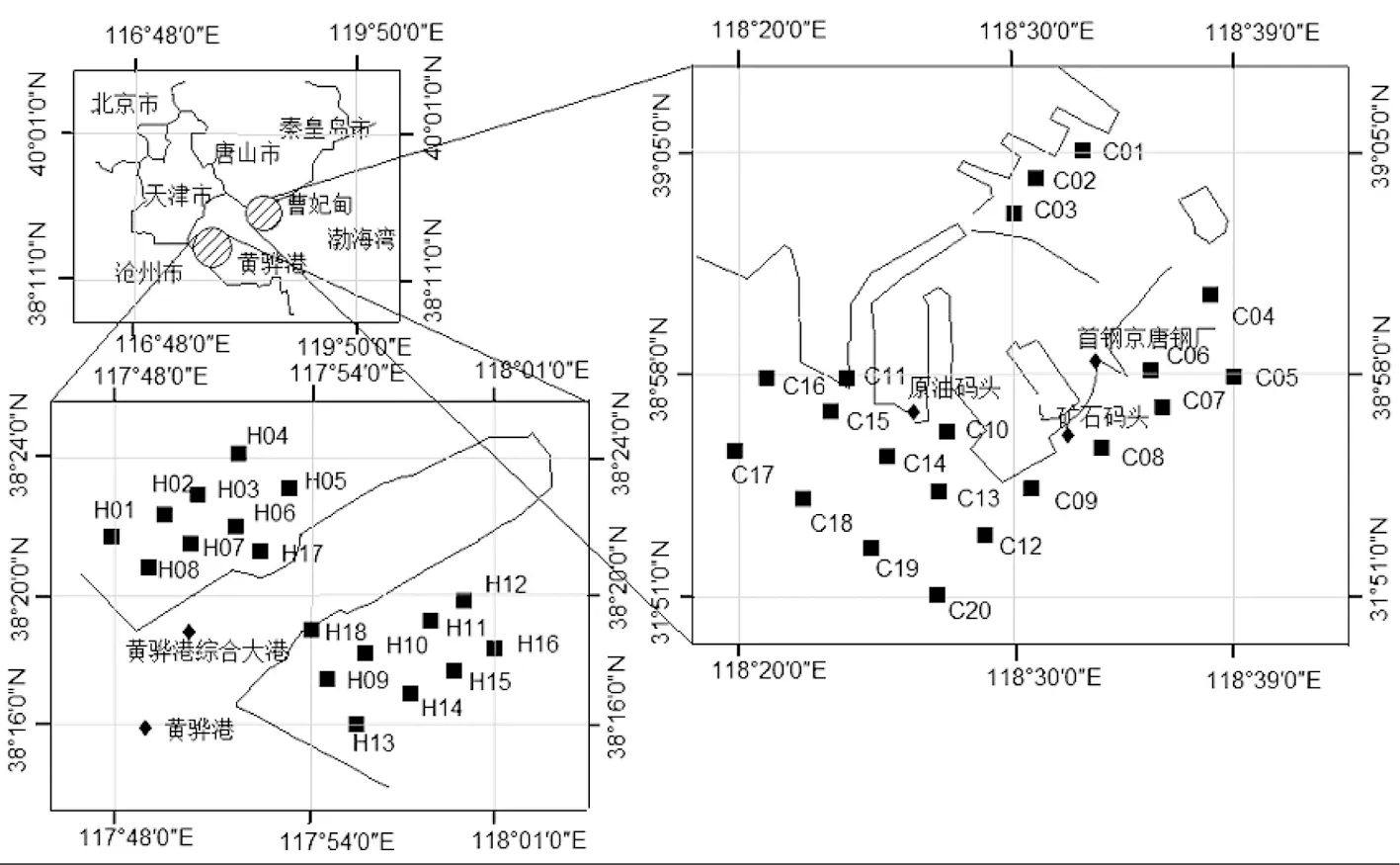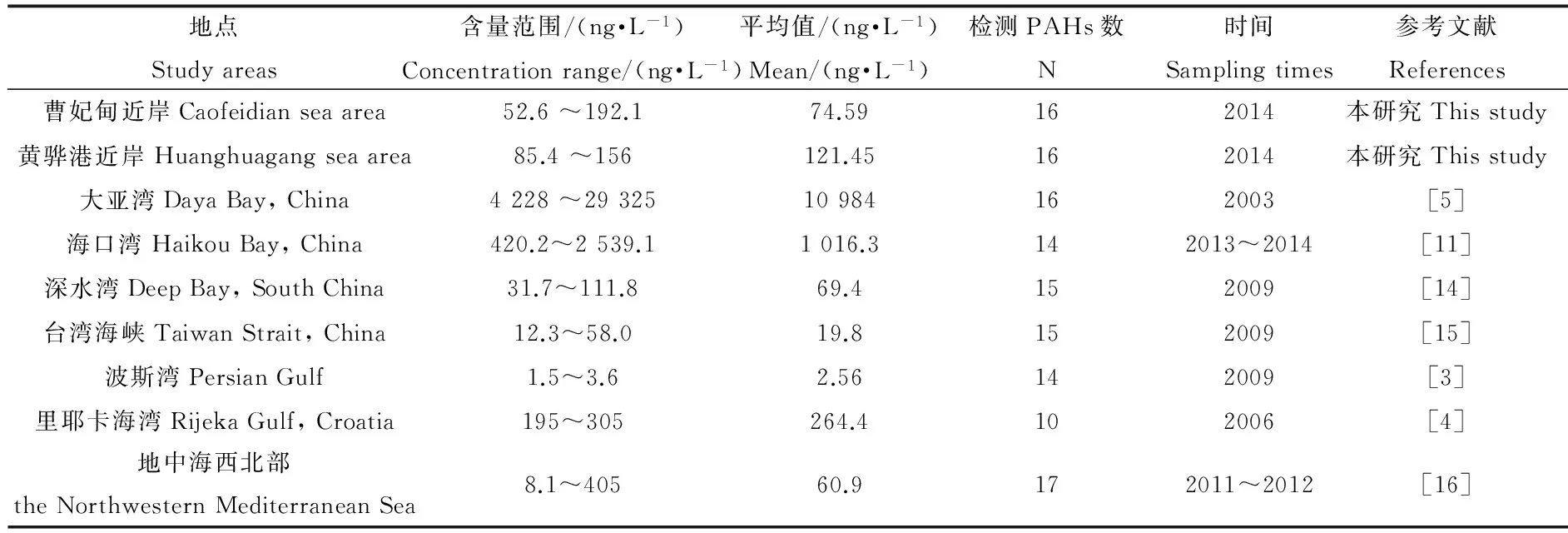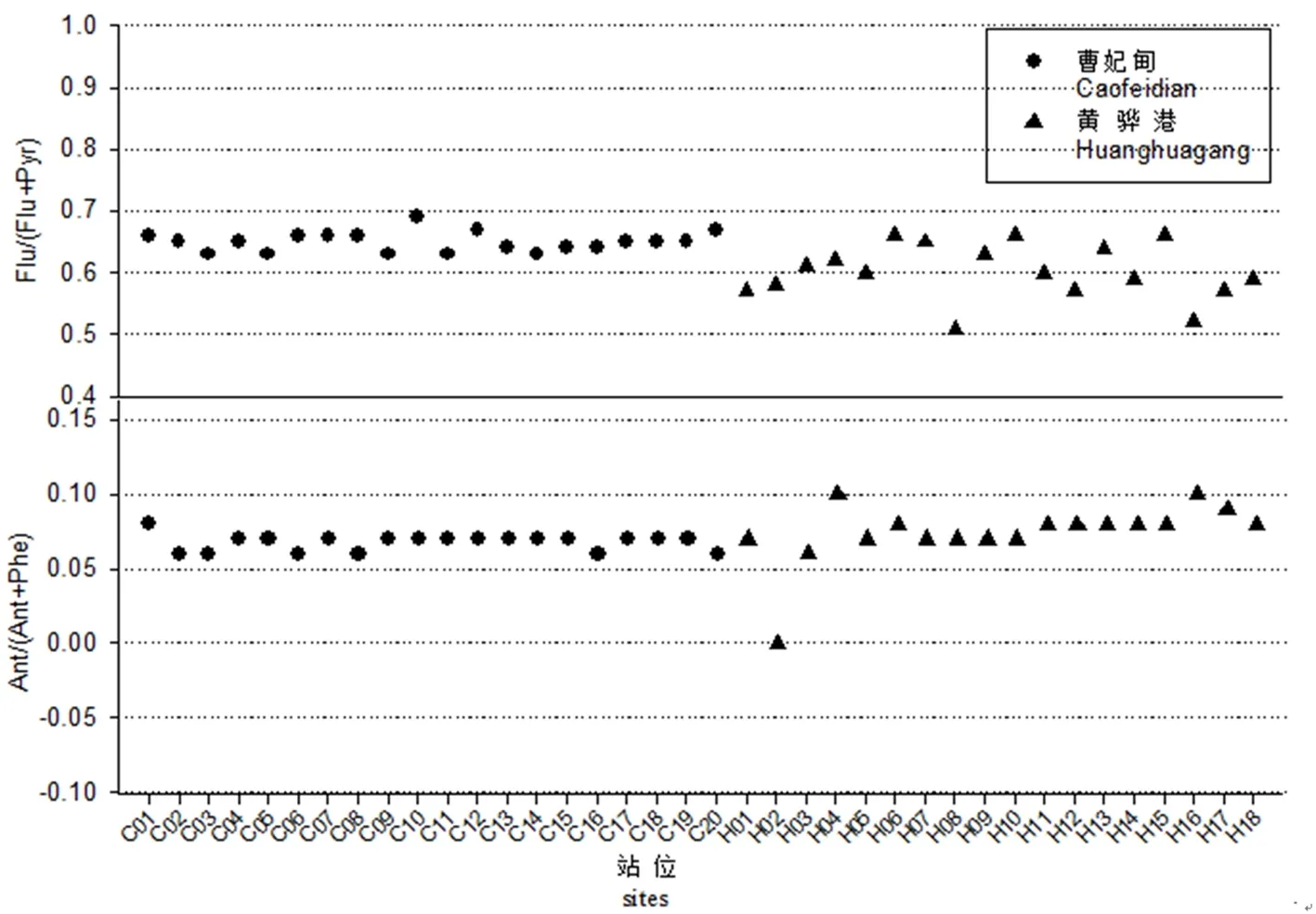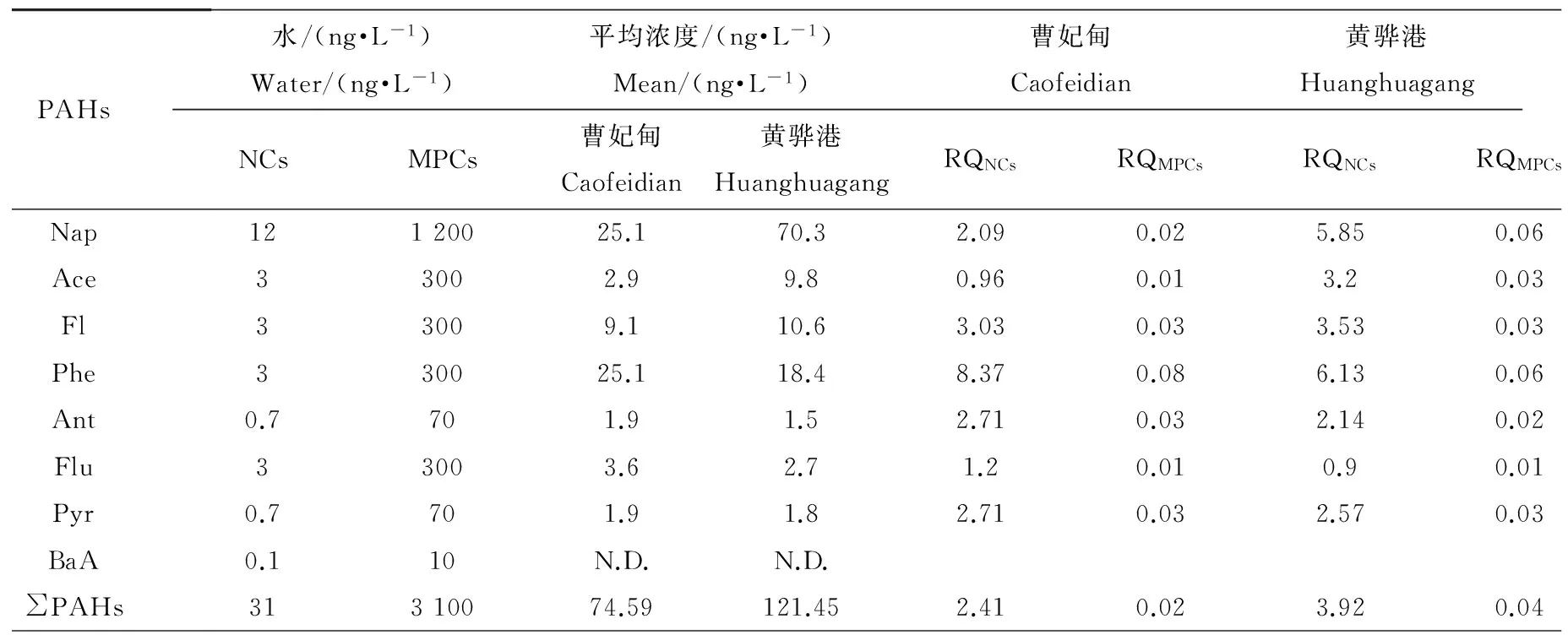曹妃甸和黄骅港近岸海域表层水体中PAHs的分布、来源及风险评价
2016-12-12刘宪斌杨文晓田胜艳梁梦宇李德亮刘春琳
刘宪斌,杨文晓,田胜艳,梁梦宇,李德亮,刘春琳
天津科技大学 天津市海洋资源与化学重点实验室,天津 300457
曹妃甸和黄骅港近岸海域表层水体中PAHs的分布、来源及风险评价
刘宪斌*,杨文晓,田胜艳,梁梦宇,李德亮,刘春琳
天津科技大学 天津市海洋资源与化学重点实验室,天津 300457
曹妃甸和黄骅港是河北省近海工业布局和港口分布较密集的区域,对其近岸海域海水水质进行监测具有重要意义。2014年9月采集研究区近岸海域表层海水,并利用GC-MS对其中16种优先控制PAHs进行测定。结果表明,曹妃甸和黄骅港近岸海域表层海水中∑PAHs含量分别为52.6~192.1 ng·L-1和85.4~156 ng·L-1,平均含量分别为74.59 ng·L-1和121.45 ng·L-1。黄骅港近岸海域∑PAHs含量高于曹妃甸近岸海域的含量,但PAHs的种类没有差异。对比其他研究区域水体中PAHs的含量,本区域表层海水中PAHs的含量处于中等水平,属于轻污染。异构体比值结合该区域现状分析初步判断,研究区表层海水中PAHs来源于石油污染和煤、生物质等的燃烧。应用风险商值法(RQ)对研究区域表层海水中PAHs的生态风险进行评价,结果表明该海域存在低生态风险,需采取措施控制PAHs的污染。
多环芳烃(PAHs);表层海水;曹妃甸;黄骅港;来源;风险评价
Received 19 August 2015 accepted 8 October 2015
多环芳烃(polycyclic aromatic hydrocarbons,简称PAHs)是一类含有2个及2个以上苯环的烃类有机污染物,具有致癌和致突变性,主要来源于人类活动,并广泛存在于大气、水体和沉积物中[1-2]。海洋环境中PAHs的污染主要来源于溢油、运输事故、燃料的不完全燃烧和市政、工业用水的排放[3]。在海洋环境中,PAHs可以分布在海水、沉积物和生物体内,且PAHs在海水中的浓度因来源、区域和季节的不同变化较大[4]。
河北省曹妃甸和黄骅港是我国重要的港口所在地,产业布局相对集中,拥有大量石化、化工、煤炭和炼钢等大型企业,如此繁荣的工业生产必然会对周边海域造成影响。近年来已有很多关于国内外水体中PAHs的报道[3,5-6],但是,关于该海域水体中PAHs的分布却鲜有报道。本文研究了2014年9月曹妃甸和黄骅港近岸海域表层海水中PAHs的分布、来源及其生态风险,为河北省近海PAHs的污染控制和临海工业区的环境保护提供科学依据。
1 材料与方法(Materials and methods)
1.1 试剂
16种US EPA优先控制PAHs的混合标样:萘(Nap)、苊(Acy)、苊烯(Ace)、芴(FI)、菲(Phe)、蒽(Ant)、荧蒽(Flu)、芘(Pyr)、苯并[a]蒽(BaA)、屈(Chr)、苯并[b]荧蒽(BbF)、苯并[k]荧蒽(BkF)、苯并[a]芘(BaP)、茚并[1,2,3-cd]芘(lnP)、二苯并[a,h]蒽(DBA)、苯并[ghi]苝(BP),回收率指示物菲-d10(Phe-d10),PAHs定量内标物芘-d10(Pyr-d10)均购自美国AccuStandard, Inc。
有机溶剂:正己烷(美国,Biologic-Reagents Inc)、二氯甲烷(美国,Biologic-Reagents Inc)、丙酮(美国,M TEDIA)均为色谱纯。
1.2 样品采集
2014年9月在曹妃甸原油码头、矿石码头和京唐钢厂等环境敏感区近岸海域布设20个站位,在黄骅港综合大港近岸海域布设18个检测站位(图1),每个采样站位用表层采水器采集1 L海水,装于洁净棕色玻璃瓶中。-4 ℃保存,24 h内运回实验室进行萃取处理。
1.3 样品预处理及分析
问指不耻向别人求教,善于与别人交流。问也是道德培育和养成的又一重要途径和方法。《论语》明确指出:“敏而好学,不耻下问。”“疑思问。”“子曰:‘三人行,必有我师焉;择其善者而从之,其不善者而改之。’”意思是,天资聪敏,勤奋好学,向地位低下的人求教而不怕人耻笑;遇到疑问时,就应该及时去请教别人。孔子说:“三个人在一起走路,其中一定有我的老师。我接受他们正确的意见,抛弃错误的观点。”俗话说“学问”,可见“学”和“问”是无法分开的,“学”是获得学问的重要途径,“问”当然也是获得知识的重要手段。又学又问,才能成为一个有“学问”的人。
采用固相萃取的方法对水样进行预处理。将采集的1 L水样沉淀后去除瓶底的浑浊物,加入回收率指示物菲-d10;用二氯甲烷、甲醇、水各10 mL分2次活化柱子(C-18);采用蠕动泵将水样以5mL·min-1的速度通过柱子,使样品富集;富集完成后,用10 mL 5%的甲醇溶液和3 mL的丙酮溶液淋洗柱子;用10 mL二氯甲烷和5 mL二氯甲烷:正己烷(1:1)洗脱,并将洗脱液收集到15 mL的玻璃离心管;氮吹浓缩至0.5 mL装入GC样品瓶中,加入内标物芘-d10,待GC-MS进行检测分析。

图1 曹妃甸和黄骅港表层海水采样站位示意图Fig. 1 Sampling locations of surface water in Caofeidian and Huanghuagang
用Agilent 7890A气相色谱/5975C质谱联用仪在SIM模式下进行定性及定量分析。各单体化合物的检出限萘和苊为0.08 ng·L-1,苊烯、芴、菲、蒽、荧蒽和芘为0.2 ng·L-1,苯并[a]蒽、屈、苯并[b]荧蒽、苯并[k]荧蒽和苯并[a]芘为0.4 ng·L-1,茚并[1,2,3-cd]芘、二苯并[a,h]蒽和苯并[ghi]苝为2 ng·L-1。
1.4 质量保证和质量控制
样品萃取时加入定量菲-d10作为回收率指示物。样品处理前,先进行以纯水为基质的加标(混标)试验。每批样品做一个方法空白,以检测实验室背景。加标回收率为85%~105%。空白中有低含量的同系物检出,含量均低于样品中含量,样品结果进行空白扣除。用芘-d10内标法定量。
1.5 风险评价方法
对于水体中PAHs,常用的生态风险评价方法有商值法、概率风险评价方法和统计分析方法[7-8],其中商值法是使用最广泛的评价方法,本文采用该法。
本文参考Kalf等[9]和Cao等[10]的研究,利用风险商值(RQ)评价PAHs可能对水生生物产生的生态风险[11-12]。
RQ=CPAHs/CQV
(1)
CPAHs指水环境中检测出的PAHs的浓度,CQV指水环境中的质量值;可忽略浓度(NCs)和最大允许浓度(MPCs)作为水环境中的质量值,由公式(1)可得最低风险商(RQNCS)和最高风险商(RQMPCs)的计算公式如下:
RQNCs=CPAHs/CQV(NCs)
(2)
RQMPCs=CPAHs/CQV(MPCs)
(3)
各PAHs和∑PAHs的RQ判定标准见表1[10,13]。
2 结果(Results)
2.1 PAHs的分布
在检测的16种优控PAHs中,调查区域海水检出的均为低环(2~4)的PAHs(Nap、Acy、Ace、FI、Phe、Ant、Flu和Pry),各站位PAHs的含量如图2所示。曹妃甸近岸海域海水PAHs总量变化范围为52.6~192.1 ng·L-1,平均含量为74.59 ng·L-1,在C10站位PAHs含量出现明显高值。黄骅港近岸海域海水PAHs总量变化范围为85.4~156 ng·L-1,平均含量为121.45 ng·L-1,各站位PAHs分布差异不大。黄骅港近岸海域海水中PAHs浓度高于曹妃甸近岸海域海水中PAHs的浓度。可能是由于黄骅港地处沧州渤海新区,石油化工、钢铁、港口等的发展较曹妃甸的发展早,污染历史相对较长。

表1 各PAHs和∑PAHs的RQ判定标准

表2 不同水域PAHs浓度比较
注: N代表PAHs在研究中的检测数目。
Note: N is the number of PAHs compounds investigated in each study.

图2 研究区域各站位PAHs的含量Fig. 2 Concentrations of PAHs from different sites

图3 曹妃甸和黄骅港海域表层水体中同分异构体的特征比值Fig. 3 Isomer ratio plots of PAHs in surface water from Caofeidian and Huanghuagang

表3 判定PAHs来源的特征比值变化范围
对比国内外其他研究区域水体中PAHs的含量(如表2)。
2.2 PAHs的组成及来源分析
曹妃甸和黄骅港表层海水中检出的PAHs均为2~4环。2环PAHs(Nap、Acy、Ace、Fl)的量占总量的58.58% ~79.17%,其中Nap为主要成分,占总量的33.7% ~57.87%。Nap是原油和轻质油油类产品的重要组成部分,可作为石油源的指示物[17]。3环PAHs(Phe、Ant、Flu)的量占总量的19.32% ~38.97%,4环PAHs(Pyr)的量占总量的1.51% ~2.45%。两区域表层海水中所检测出的PAHs的种类一致,其含量差异不大,说明这两区域污染源基本一致。
利用具有一定稳定性PAHs异构体对(Phe/Ant、Flu/Pyr和lnP/BP系列)作为源解析的分子标志物对研究区PAHs的来源进行分析[18~21]。表3列出了这些异构体比值的判断标准。比较本文中几种同分异构体的比值(如图3),曹妃甸近岸海域表层海水所有站位Ant/(Ant+Phe)<0.1,表明其来源于石油污染;黄骅港H04和H16两个站位Ant/(Ant+Phe)=0.1,其余站位Ant/(Ant+Phe)<0.1,表明其来源于石油污染。曹妃甸和黄骅港近岸海域表层海水所有站位Flu/(Flu+Pyr)>0.5,表示来源为煤、生物质的燃烧。
2.3 PAHs的生态毒性风险评价
PAHs具有致癌、致畸和致突变性,有研究表明对于水生生物LWM(低分子量)PAHs比HWM(高分子)PAHs会暴露出更高的毒性,鱼类等水生生物更可能直接从水中摄入PAHs[1,3]。目前,我国关于PAHs的海水水质标准只规定了苯并芘含量不能超过2.5 ng.L-1[22],尚未对其他PAHs含量作出相应标准,但对其他PAHs的生态风险评价仍很有必要。
利用风险商值(RQ)评价PAHs可能产生的生态风险,水环境中NCs和MPCs值及本研究中各PAHs的RQ值结果列于表4。
由表4可以看出,曹妃甸近岸海域表层海水中Nap、Fl、Phe、Ant、Flu和Pyr的RQNCs值均大于1,RQMPCs值小于1,表明该区域中Nap、Fl、Phe、Ant、Flu和Pyr存在低风险,风险值较高的是菲(RQNCs=8.37)。黄骅港近岸海域表层海水中Nap、Ace、Fl、Phe、Ant和Pyr的RQNCs值均大于1,RQMPCs值小于1,表明该区域中Nap、Ace、Fl、Phe、Ant和Pyr存在低风险,菲的风险值(RQNCs=6.13)较高。两区域中1≤RQ∑PAHs(NCs)<800,RQ∑PAHs(MPCs)﹤1,表明两区域中∑PAHs的生态风险低。
3 讨论(Discussions)
与国内外其他研究区域水体对比,曹妃甸和黄骅港近岸表层海水PAHs的含量远小于大亚湾表层海水和海口湾等水体中PAHs的含量,高于深水湾和台湾海峡等水体中PAHs的含量,处于中等水平。此外,PAHs的污染程度可分为4个等级:微污染(10~50 ng·L-1)、轻污染(50~250 ng·L-1)、中度污染(250~1 000 ng·L-1)和重污染(≥1 000 ng·L-1)[23]。曹妃甸和黄骅港近岸海域表层海水中PAHs的含量分别为52.6~192.1 ng·L-1和85.4~156 ng·L-1,因此两个区域表层海水中PAHs污染程度均属于轻污染。

表4 NCs和MPCs值及本研究中PAHs的RQ值
注:N.D.表示未检出,NCs为可忽略浓度,MPCs为最大允许浓度。
Note: N.D. represents the concentration of PAHs is below the detection limit. NCs stands for the negligible concentrations, MPCs stands for the maximum permissible concentrations.
异构体比值结果Ant/(Ant+Phe)<0.1和Flu/(Flu+Pyr)>0.5表明,曹妃甸和黄骅港近海表层海水中PAHs并非来源于单一且贡献较强的污染源,这与Katsoyiannis等[24]对英国12个不同地区大气中PAHs来源分析结果相似。2010年张耀丹等[17]对该区域PAHs的来源分析结果表明PAHs的来源以石油污染为主,燃烧源也有一定的贡献。自2010年以来,曹妃甸工业区石油化工、钢铁、电力等产业的继续发展,使得煤和生物质的燃烧成为PAHs的一大来源;同样黄骅港地处沧州渤海新区,燃烧源的贡献也很大。因此,煤、生物质等的燃烧可能已成为该区域PAHs的主要来源之一。另外,曹妃甸和黄骅港内码头较多,海上活动频繁,石油污染依旧是PAHs的主要来源。因此,初步判断曹妃甸和黄骅港近岸海域海水中PAHs的来源为石油污染和煤、生物质等的燃烧。
风险商值(RQ)对PAHs的评价结果表明,曹妃甸和黄骅港近岸海域表层海水中的PAHs存在低风险,其中菲的风险值较高,且菲不易通过光降解、生物利用和挥发而减少[25]。随着工业和海上运输业的不断发展,PAHs污染日益严重,会进一步影响生态环境,因此需要采取措施来控制曹妃甸和黄骅港近岸海域海水中PAHs的浓度,尤其是菲的浓度,防止生态风险的进一步增加。
致谢:国家海洋局秦皇岛海洋监测中心站在采样方面提供了帮助,评审老师对文章修改提供的宝贵意见,在此一并致谢。
[1] Law R J, Dawes V J, Woodhead R J, et al. Polycyclic aromatic hydrocarbons (PAH) in seawater around England and Wales [J]. Marine Pollution Bulletin, 1997, 34(5): 306-322
[2] 刘宏文, 王震, 刘景泰, 等. 大连市饮用水中多环芳烃的概率致癌风险评价[J]. 安全与环境学报, 2007, 7(5): 4-7
Liu H W, Wang Z, Liu J T, et al. Probabilistic cancer risk assessment of polycyclic aromatic hydrocarbons in drinking water in Dalian, China [J]. Joumal of Safety and Environment, 2007, 7(5): 4-7 (in Chinese)
[3] Mirza R, Mohammadi M, Dadolahi S A, et al. Polycyclic aromatic hydrocarbons in seawater, sediment, and rock oyster Saccostrea cucullata from the Northern Part of the Persian Gulf (Bushehr Province) [J]. Water, Air and Soil Pollution, 2011, 223(1): 189-198
[4] Bihari N, Fafandel M, Piskur V. Polycyclic aromatic hydrocarbons and ecotoxicological characterization of seawater, sediment, and mussel Mytilus galloprovincialis from the Gulf of Rijeka, the Adriatic Sea, Croatia [J]. Archives of Environmental Contamination and Toxicology, 2007, 52(3): 379-387
[5] Zhou J L, Maskaoui K. Distribution of polycyclic aromatic hydrocarbons in water and surface sediments from Daya Bay, China [J]. Environmental Pollution, 2003, 121(2): 269-281
[6] Guo W, He M, Yang Z, et al. Distribution of polycyclic aromatic hydrocarbons in water, suspended particulate matter and sediment from Daliao River watershed, China [J]. Chemosphere, 2007, 68(1): 93-104
[7] 董继元, 王式功, 尚可政. 黄河兰州段多环芳烃生态风险的初步评价方法[J]. 干旱区资源与环境, 2011, 25(4): 50-55
Dong J Y, Wang S G, Shang K Z. Preliminary assessment on ecological risk of polycyclic aromatic hydrocarbons at the Lanzhou section of the Yellow River [J]. Journal of Arid Land Resources and Environment, 2011, 25(4): 50-55 (in Chinese)
[8] 冯承莲, 雷炳莉, 王子健. 中国主要河流中多环芳烃生态风险的初步评价[J]. 中国环境科学, 2009, 29(6): 583-588
Feng C L, Lei B L, Wang Z J. Preliminary ecological risk assessment of polycyclic aromatic hydrocarbons in main rivers of China [J]. China Environment Science, 2009, 29(6): 583-588 (in Chinese)
[9] Kalf D F, Crommentuijn T, van de Plassche E J. Environmental quality objectives for 10 polycyclic aromatic hydrocarbons (PAHs) [J]. Ecotoxicology and Environmental Safety, 1997, 36(1): 89-97
[10] Cao Z G, Liu J L, Luan Y. Distribution and ecosystem risk assessment of polycyclic aromatic hydrocarbons in the Luan River, China [J]. Ecotoxicology, 2010, 19(5): 827-837
[11] Li Y H, Li P, Ma W D. Spatial and temporal distribution and risk assessment of polycyclic aromatic hydrocarbons in surface seawater from the Haikou Bay, China [J]. Marine Pollution Bulletin, 2015, 92: 244-251
[12] Sun J H, Wang G L, Chai Y, et al. Distribution of polycyclic aromatic hydrocarbons (PAHs) in Henan Reach of the Yellow River, Middle China [J]. Ecotoxicology and Environmental Safety, 2009, 72(5): 1614-1624
[13] 曹治国, 刘静玲, 王雪梅, 等. 漳卫南运河地表水中溶解态多环芳烃的污染特征、风险评价与来源辨析[J]. 环境科学学报, 2010, 30(2): 254-260
Cao Z G, Liu J L, Wang X M, et al. Pollution characteristics, ecological risk assessment and sources of polycyclic aromatic hydrocarbons (PAHs) in surface water from Zhangweinan River [J]. Acta Scientiae Circumstantiae, 2010, 30(2): 254-260 (in Chinese)
[14] Qiu Y W, Zhang G, Liu G Q, et al. Polycyclic aromatic hydrocarbons (PAHs) in the water column and sediment core of Deep Bay, South China [J]. Estuarine, Coastal and Shelf Science, 2009, 83(1): 60-66
[15] Wu Y L,Wang X H, Li Y Y, et al. Occurrence of polycyclic aromatic hydrocarbons (PAHs) in seawater from the Western Taiwan Strait, China [J]. Marine Pollution Bulletin, 2011, 63(5-12): 459-463
[16] Guigue C, Tedetti M, Ferretto N, et al. Spatial and seasonal variabilities of dissolved hydrocarbons in surface waters from the Northwestern Mediterranean Sea: Results from one year intensive sampling [J]. Science of the Total Environment, 2014, 466: 650-662
[17] 张耀丹, 田胜艳, 刘宪斌, 等. 渤海西北部海域表层水体中PAHs的分布、来源及风险评价[J]. 海洋与湖沼, 2013, 44(1): 255-261
Zhang Y D, Tian S Y, Liu X B, et al. Distribution, source and ecological risk assessment of polycylic aromatic hydrocarbons in surface water from the northwest Bohai Sea, China [J]. Oceanologiaet Limnologia Sinica, 2013, 44(1): 255-261 (in Chinese)
[18] 程远梅, 祝凌燕, 田胜艳, 等. 海河及渤海表层沉积物中多环芳烃的分布与来源[J]. 环境科学学报, 2009, 29(11): 2420-2426
Cheng Y M, Zhu L Y, Tian S Y, et al. Distribution and sources of polycyclic aromatic hydrocarbons in surface sediments from the Haihe River and the Bohai Sea [J]. Acta Scientiae Circumstantiae, 2009, 29(11): 2420-2426 (in Chinese)
[19] Yunker M B, Macdonald R W, Vingarzan R, et al. PAHs in the Fraser River basin: A critical appraisal of PAH ratios as indicators of PAH source and composition [J]. Organic Geochemistry, 2002, 33(4): 489-515
[20] 曹治国, 刘静玲, 栾芸, 等. 滦河流域多环芳烃的污染特征、风险评价与来源辨析[J]. 环境科学学报, 2010, 30(2): 246-253
Cao Z G, Liu J L, Luan Y, et al. Pollution characteristics, risk assessment and source apportionment of polycyclic aromatic hydrocarbons (PAHs) in sediment and water of the Luan River, China [J]. Acta Scientiae Circumstantiae, 2010, 30(2): 246-253 (in Chinese)
[21] Zhang J, Liu G, Yuan Z, et al. Levels and distributions of polycyclic aromatic hydrocarbons (PAHs) in middle reach of Huaihe River, China: Anthropogenic influences and ecological risks [J]. Natural Hazards, 2014, 74(2): 705-716
[22] 国家海洋局第三海洋研究所. GB 3097-1997 中华人民共和国国家标准:海水水质标准[S]. 北京: 环境科学出版社, 2004: 200-205
[23] Li P, Cao J, Diao X P. Spatial distribution, sources and ecological risk assessment of polycyclic aromatic hydrocarbons in surface seawater from Yangpu Bay, China [J]. Marine Pollution Bulletin, 2015, 93: 53-60
[24] Katsoyiannis A, Sweetman A J, Jones K C. PAHs molecular diagnostic ratios applied to atmospheric sources: A critical evaluation using two decades of source inventory and air concentration data from the UK [J]. Environmental Science and Technology, 2011, 45(20): 8897-8908
[25] Tolosa I, de Mora S, Sheikholeslami M R, et al. Aliphatic and aromatic hydrocarbons in coastal Caspian Sea sediments [J]. Marine Pollution Bulletin, 2004, 48(1-2): 44-60
◆
Distribution, Source and Ecological Risk Assessment of Polycyclic Aromatic Hydrocarbons in Surface Water from the Caofeidian and Huanghuagang, China
Liu Xianbin*, Yang Wenxiao, Tian Shengyan, Liang Mengyu, Li Deliang, Liu Chunlin
Tianjin Key Laboratory of Marine Resources and Chemistry, Tianjin University of Science & Technology, Tianjin 300457, China
It is important to monitor the quality of the seawater near Caofeidian and Huanghuagang, Hebei Province, China, where there are more industrial layout and ports. Surface seawater samples were collected and 16 priority polycyclic hydrocarbons (PAHs) were analyzed by GC/MS in September 2014. Total PAHs concentrations in the surface seawater from Caofeidian and Huanghuagang varied in the range of 52.6~192.1 ng·L-1and 85.4~156 ng·L-1, with the mean values of 74.59 ng·L-1and 121.45 ng·L-1, respectively. The levels of PAHs in Huanghuagang sea area were higher than those in Caofeidian sea area, with no difference in the kinds of PAHs. Compared with the reports about PAHs in seawater all over the world, the concentrations of PAHs in the surface seawater from the Caofeidian and Huanghuagang were medium and at light-polluted level. The measured PAHs mainly came from oil and combustion of coal and biomass, and etc. according to the ratios of isomer and analysis of the current conditions of the two areas. Risk quotients (RQ) results showed that there was low ecological risk in these areas and some measurements should be taken to control the pollution of PAHs.
polycyclic aromatic hydrocarbons (PAHs); surface water; Caofeidian; Huanghuagang; source; risk assessment
10.7524/AJE.1673-5897.20150819001
天津市蓬莱19-3油田溢油事故补偿款项目(19-3BC2014-05)
刘宪斌(1964-),男,博士,教授,研究方向为环境生态修复,E-mail:lxb0688@tust.edu.cn
2015-08-19 录用日期:2015-10-08
1673-5897(2016)2-742-07
X171.5
A
简介:刘宪斌(1964-),男,博士,教授,主要研究方向为环境调查与评价、污染环境修复原理与技术。
刘宪斌, 杨文晓, 田胜艳, 等. 曹妃甸和黄骅港近岸海域表层水体中PAHs的分布、来源及风险评价[J]. 生态毒理学报,2016, 11(2): 742-748
Liu X B, Yang W X, Tian S Y, et al. Distribution, source and ecological risk assessment of polycyclic aromatic hydrocarbons in surface water from the Caofeidian and Huanghuagang, China [J]. Asian Journal of Ecotoxicology, 2016, 11(2): 742-748 (in Chinese)
